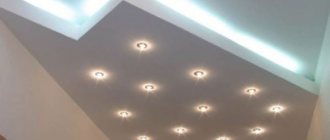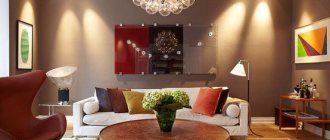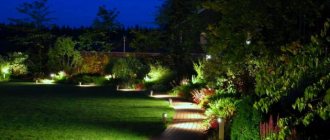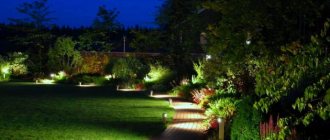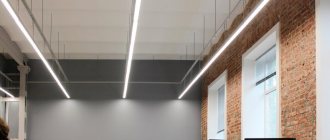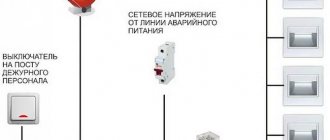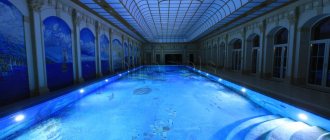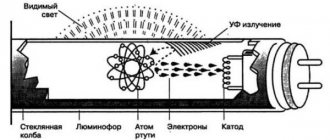Proper lighting of production premises ensures comfort for company employees and improves the quality of products. With proper placement of light openings in external walls and internal lamps, suitable conditions are created for efficient production, orientation on the ground and the performance of tasks of varying complexity and accuracy by employees. To avoid the occurrence of traumatic situations, to provide the opportunity for long-term concentration of personnel on work operations without damaging vision and minimizing defects, it is important to take into account the requirements for the organization of industrial lighting.
1.1. General principles of lighting regulation
Lighting installations for industrial and domestic use must provide the required visibility (discernibility) of objects. General requirements for lighting installations can be divided into lighting, economic and safety requirements. The economic and safety requirements for lighting installations are basically the same as for other electrical installations.
Lighting requirements are as follows: sufficient brightness, or illumination of the illuminated surface, favorable uniformity of illumination, constancy of illumination over time, necessary limitation of glare, absence of sharp and deep shadows and favorable direction of the light flux.
The visibility of an object depends on its contrast with the background, the level of background brightness and the angular size of the object. The size of the object under consideration and its contrast with the background are determined by the nature of visual work, therefore the level of visibility of the object depends entirely on the level of background brightness created by the lighting installation. Difficulties arise in measuring and calculating brightness in practice. In this regard, the rules in force in Russia and abroad standardize illumination, not brightness. In this case, the background reflectance coefficient is regulated. Strictly speaking, such normalization is valid only for a diffusely reflective background and is completely unacceptable for a background with directional (mirror) reflection. Illumination standards are intended to ensure the required level of visibility with acceptable consumption of electricity, materials and equipment.
Most foreign lighting standards are advisory in nature. They normalize the average illumination. Domestic standards regulate the minimum illumination in the workplace. Departmental and industry standards are developed on the basis of general standards. They contain instructions for lighting rooms and workplaces specific to a given industry or department.
Calculation of artificial lighting
The calculation is aimed at determining the required number and power of lighting fixtures for a specific room. It is produced in two ways:
- Spot – general and localized placement of lighting equipment is calculated.
- Utilization factor method - the average illumination value is calculated taking into account the reflection of the incident light. Used to determine overall uniform illumination.
If you plan to use incandescent lamps, first choose their location, then calculate the required power.
For fluorescent (daylight) ones, the quantity and location are determined, and then mounted in groups, taking into account the power.
You can familiarize yourself with the main programs for calculating and designing lighting on our website.
1.2. Types of lighting
Lighting is divided by type into working, intended to create normal working conditions, and emergency, which can have one of two purposes: to continue work when the working light goes out; for the evacuation of people from production premises.
The installation of working lighting is mandatory in all cases, regardless of the presence of emergency lighting.
Emergency lighting for continued work is required in indoor and outdoor spaces if interruption of normal work due to lack of working lighting may cause:
· explosion, fire, poisoning of people;
· long-term disruption of the technological process;
· disruption of the work of vital centers of enterprises and cities serving communications, electricity and water supply, etc.;
· danger of injury in crowded places; disruption of the normal operation of operating rooms, emergency rooms and emergency rooms of medical institutions.
This lighting should create on surfaces requiring maintenance an illumination of 5% normalized for one general lighting, and in the absence of special justifications - ranging from 2 to 30 lux in buildings and from 1 to 5 lux outside them.
Emergency lighting for the evacuation of people (in buildings or outside them) is necessary:
· in places dangerous for the passage of people;
· along evacuation routes for people from industrial and public premises where more than 50 people are present;
· on the stairs of residential buildings with a height of 6 floors or more;
· in all production premises with more than 50 employees and other premises with more than 100 people staying;
· in industrial premises with constantly working people, whose exit in the dark is dangerous due to the continued operation of the equipment.
This lighting should create an illumination of 0.5 lux in the passages in buildings and 0.2 lux outside them.
For emergency lighting, only incandescent or fluorescent lamps can be used; It is allowed to attach DRL or DRI lamps to emergency lighting groups to increase illumination above the standard for emergency mode.
Emergency lighting lamps are predominantly distinguished from among working lighting lamps: in rooms where they work in 1-2 shifts, with a power of working lighting lamps of 200 W, it is more preferable to install additional lamps.
If emergency lighting fixtures do not differ from others in type or size, then they must be marked with special signs.
Exits from industrial premises without natural light with an area of 150 m2 or more and from non-industrial premises with stay in them for more than
100 people must be indicated by illuminated signs connected to the emergency lighting network.
The installation of emergency lighting for entertainment enterprises is regulated by separate rules.
Types of industrial lighting
Electric lighting of premises intended for production is divided into four types:
- Work - serves to organize the working conditions required to solve specific problems. It is provided in working and utility spaces, places of passage of people, and movement of vehicles. For efficient distribution of light, separate zones with different lighting arrangements are allocated: general and local.
- Emergency – illuminates the road for evacuation in the event of an emergency or when the general light is turned off. It looks like light openings in external walls and additional lighting sources. Placed on stairs and corridors.
- Security – designed to control the safety of production values.
- On duty – used during non-working hours.
1.3. Lighting system
Lighting can be general uniform, general localized (made taking into account the location of workplaces) or combined, consisting of general lighting of the room and local lighting of work surfaces. The installation of only local lighting in premises is prohibited.
Temporary local lighting, carried out primarily by hand-held lamps, is called portable.
The standards (hereinafter referred to as SNiP II-A.9-71) recommend combined lighting for rooms with work of categories I - IV, Va and Vb, but if it is impossible or impractical to install such lighting, a system of one general lighting is allowed, which has some hygienic and aesthetic benefits.
The combined lighting system is used where there is:
· high precision of work performed;
· specific requirements for the quality of lighting (for example, for the direction of light);
· limited area of working surfaces;
· large room area per workplace;
· Possibility of rearranging jobs.
Otherwise, one general lighting is used.
If possible, it is preferable to arrange general lighting of industrial premises in a localized manner, which is favored by the large size of the illuminated surfaces or their placement in concentrated groups or rows.
In non-production premises, general lighting is provided, usually uniform (exceptions are possible, in particular, when placing tables in fixed rows, in exhibition rooms, etc.).
Additional local lighting required by the standards for some premises is, if necessary, arranged at individual workplaces, and this requirement should not be understood as a requirement for a combined lighting device.
Plug sockets for connecting portable lighting are required in all rooms with machinery or production containers, and must allow the use of hand-held lamps with a limited wire length. In some areas of non-industrial buildings (for example, in corridors) they are also used to turn on vacuum cleaners and electric floor polishers.
What is natural light and what types of lighting are there?
Before we begin to analyze the basic concepts of natural lighting, let's figure out what it actually is and what types of lighting are there? SNiP 23 - 05 - 95 will help us answer this question, which, in fact, standardizes all types of lighting.
So, lighting can be natural, combined and artificial:
- Natural lighting is the light obtained from the sun's energy.
- Artificial lighting is called lighting obtained from light sources created by human hands (see Artificial and natural lighting: basic concepts and stages of calculation).
- And combined is called lighting, part of which is obtained from the energy of the sun, and part from light sources created by human hands.
Side natural lighting
Natural lighting, in turn, is divided into several types - top, side and combined. As the name implies, these types depend on the plane of incidence of light into the room. If it's a glass roof, then it's overhead lighting. If this is a window in the wall, then side lighting. Combined lighting is lighting that combines top and side lighting.
Overhead natural lighting
Overhead lighting creates fewer shadows and is more difficult to shade. But at the same time, it can only be organized in one-story buildings or on the upper floors of multi-story buildings. And we must not forget about heat losses from this type of lighting.
Combined natural lighting
Based on this, side lighting is used much more often. It can be implemented in buildings of any type, and it does not hurt the energy efficiency of the structure so much.
At the same time, in buildings of great depth (with a large distance from the window to the opposite wall), it is extremely difficult to implement this type of lighting with your own hands. In such buildings, combined natural or combined lighting is usually used.
1.5. Lighting quality
The quality of lighting is characterized by a large number of characteristics, largely interrelated, including:
· degree of limitation of direct and reflected brightness;
· constancy of illumination: this refers to both changes occurring due to deviations and voltage fluctuations, and pulsations of the flow of gas-discharge lamps powered by alternating current;
· spectral composition of light, determined by the choice of light sources;
· brightness of surfaces that are in the field of view, but are not working;
· depth and character of shadows;
· direction of light;
· uniformity of lighting (standardized only for streets and roads).
In some cases, the required quality of lighting is achieved by special techniques: translucent lighting, lighting with large surfaces, artificial background, colored light, etc.
For industrial premises, limiting the glare created by direct glare is achieved by normalizing the glare indicator P
, characterizing a decrease in contrast sensitivity when exposed to glare.
P value
not limited to:
· for rooms no more than two heights of lamps above the floor;
· for categories VIIIb, VIIIc, IXb, XIIIa, XIIIb;
· for categories X, XI, XIIa, XIIb, XIIIc - with lamps with a protective angle of at least 15° or with diffusers with an overall brightness in the 60-90° zone of no more than 4 cd/m2;
· for rooms with a height of up to 2.5 m when performing work of categories VI and VIIIa or during temporary stay of people and for all areas intended for passage or maintenance of equipment, when using lamps with a protective angle of at least 15° for incandescent lamps and no more than 150 W, for DRL lamps no more than 250 W and fluorescent lamps with a total power of no more than 80 W; lamps with frosted and milky diffusers without reflectors for incandescent lamps not exceeding 100 W; open incandescent lamps no more than 60 W in a milk flask and fluorescent lamps no more than 40 W.
Table 1.5.1. Glare indicator in production and auxiliary premises
| Work category and subcategory | Indicator of blindness when people are in the room | |
| permanent | temporary | |
| I, II | 20 | — |
| III, IV, V, VII | 40 | 60 |
| VI, VIIIa, IXa, X, XI, XIIa | 60 | 80 |
| Notes. 1. Cases in which the blindness indicator is not standardized are indicated in the text. 2. The indicator should be determined under the outermost lamp of the middle row or one of two rows, along the axes of vision or the long side of the room, and with fluorescent lamps, if the axes of vision are directed across the rows of lamps or the length of the room is less than 5 times the height of the suspension, in the middle of the outermost a row of lamps against the wall, in a direction across the rows. | ||
On stairs, the luminous parts of the lamps should not be visible within the corner
±10° to the horizon. Open fluorescent lamps with a total power of no more than 40 W in the luminaire are allowed.
Local lighting lamps must have a protective angle of at least 30°, and when located below eye level, 10-30°.
Rice. 1. Protective angle of the lamp
:
h - distance from the lamp filament to the level of the lamp outlet;
R is the radius of the lamp outlet; r is the radius of the lamp filament ring; b - protective angle The protective angle of the lamp is the angle formed by the horizontal passing through the filament body of the lamp and the line connecting the point of the filament body with the opposite edge of the reflector.
When the network voltage changes by 1.5%, the eye notices fluctuations in illumination. The frequency of voltage fluctuations in the lighting network in the range from 1.5 to 4% should not exceed 10 fluctuations per hour, and with voltage changes exceeding 4%, the frequency of fluctuations should not exceed 1 fluctuation per hour.
Lamps must be installed so as to prevent them from swinging or spontaneous movement. Combined power supply from one network of lighting installations and power consumers is possible if welding machines, large electric motors with frequent starting or reversing, and other consumers with powerful shock loads are not connected to it.
For public buildings, the discomfort index M
, characterizing additional visual strain in the presence of high brightness.
The value of M
is not limited for rooms with a length of no more than double the height of the lamp above the floor, for passages, corridors, dressing rooms, sanitary facilities, storerooms, stairs and rooms for short-term stays of people.
The apparent degree of saturation of a room with light is largely determined by the value of cylindrical illumination, the recommended values of which are indicated in table. 1.5.2.
Limitation of reflected glare is achieved mainly by appropriate choice of light direction, use of diffuse lighting or illumination of large luminous surfaces.
Increasing the brightness of room surfaces, in particular walls and ceilings, is advisable when their reflection coefficient is high and is achieved by using lamps that emit part of the luminous flux into the upper hemisphere. The presence of such radiation also softens shadows.
Table 1.5.2. Lighting quality indicators for public buildings
| Desired level of light saturation in the room | Recommended cylindrical illumination, lux | Conditions for visual work | Acceptable level of discomfort |
| Large (for example, meeting rooms) | 150 | The preferred direction of the line of sight is upward at an angle of 45° to the horizon (hospital wards, etc.) | 25 |
| Elevated (auditoriums and foyers of theaters, trading floors of department stores, etc.) | 100 | High precision work (design offices, reading rooms, etc.) | 40 |
| Normal (assembly halls, cinema foyers, etc.) | 75 | General overview of the space without the need to distinguish small objects (foyers, lobbies, etc.) | 60 |
| Note. Indicators are determined at the end wall on the central longitudinal axis at a height of 1.5 m from the floor. | |||
Table 1.5.3. Installation height of luminaires in the territories of industrial enterprises and in places where work is carried out outside buildings according to the conditions for limiting glare
| Lamp | Total luminous flux of lamps installed on one support, lm | Minimum installation height of luminaires, m, with lamps | ||
| incandescent and sodium | DRL and DRI | luminescent | ||
| With incandescent lamps, DRL and DRI, having a conditional protective angle of at least 15°, and with fluorescent lamps, regardless of the protective angle | 6 | 6 | 6 | |
| 5000—10000 | 6 | 6 | 6,5 | |
| 10000—20000 | 6,5 | 7 | 7,5 | |
| 20000—30000 | 7,5 | 8,5 | 9 | |
| 30000—40000 | 9 | 10 | 10,5 | |
| >40000 | 10,5 | 11 | 12 | |
| With incandescent lamps, DRL and DRI, having a conditional protective angle of at least 15°, and wide light distribution with mirror and prismatic systems | 7 | 7,5 | 6 | |
| 5000—10000 | 8 | 8,5 | 6,5 | |
| 10000—20000 | 9 | 9,5 | 7,5 | |
| 20000—30000 | 10,5 | 11 | 9 | |
| 30000—40000 | 12 | 12,5 | 10,5 | |
| >40000 | 13,5 | 14 | 12 | |
| Notes. 1. The installation height of luminaires with any lamps with a protective angle of at least 15° or lenses without reflectors is not limited when lighting areas for the passage of people or equipment, pedestrian paths or entrances to buildings. | ||||
Table 1.5.4. The lowest height of outdoor lighting fixtures on streets and roads of category B and in lighting installations for which average illumination is standardized
| Characteristics of the lamp | Maximum luminous flux of lamps of one lantern, lm | Minimum installation height, m | |
| incandescent lamps | gas discharge lamps | ||
| Crowning diffused light fixtures | 3,0 | 3,0 | |
| >6000 | 4,0 | 4,0 | |
| Semi-wide light distribution luminaires | 6,5 | 7,0 | |
| 5000—10000 | 7,0 | 7,5 | |
| 10000—20000 | 7,5 | 8,0 | |
| 20000—30000 | — | 9,0 | |
| 30000—40000 | — | 10,0 | |
| >40000 | — | 11,5 | |
| Wide light distribution luminaires | 7,0 | 7,5 | |
| 5000—10000 | 8,0 | 8,5 | |
| 10000—20000 | 9,0 | 9,5 | |
| 20000—30000 | — | 10,5 | |
| 30000—40000 | — | 11,5 | |
| >40000 | — | 13,5 | |
Table 1.5.5. Standards for quality indicators of lighting of streets, roads and squares of populated areas
| Index | Standardized value, no more |
| Glare indicator for streets, roads and transport zones of areas of category A&B | 150 |
| Ratio of the highest to the lowest brightness of coatings with normalized average brightness, cd/m2: >0,6 ≤0,6 | 3,0 5,0 |
| The ratio of the greatest horizontal illumination to the average at the average illumination rate, lux: >6 4—6 | 3,0 5,0 10,0 |
Requirements for lighting of industrial premises
Regulatory acts contain the following basic requirements for industrial lighting:
- the illumination of the premises is distributed evenly;
- lighting standards for a specific type of work are met;
- the functioning of light sources is stable;
- general lighting of work activity areas is more intense than local lighting;
- corridors and production areas where no work is being done are illuminated by more than 25% of the general light standards and not less than 100 lux;
- there are no sharp shadows from lamps;
- luminous elements of local sources are not in the field of view of employees;
- local lamps are equipped with opaque reflectors.
Particular importance is attached to life safety when using lighting devices:
- The use of incandescent lamps with a power of 100 W or more is prohibited;
- color temperature of luminaires is allowed in the range from 2400°K to 6800°K;
- ultraviolet waves with a length of 320–400 nm cannot be more intense than 0.03 W/m², the presence of ultraviolet with a wavelength of less than 320 nm is prohibited.
Lighting standards and requirements
In order to properly regulate lighting, you need to strictly follow SanPiN and other regulatory documents. All requirements can be divided into those related to illumination itself and those related to the quality of light. Requirements common to all industries:
- the illumination is sufficient for each person;
- the employee can adjust the lighting - direct the light in the desired direction, change its intensity;
- In addition to artificial light, there must be natural light;
- all lamps on the ceiling and walls should be of a muted color; the light bulbs do not cause visual discomfort.
Lighting when working on a PC
Long, daily work with a computer often causes decreased vision in employees. Such problems can be eliminated or slowed down by following the rules and recommendations:
- luminous flux - 300 Lux;
- the brightness of elements in lighting devices is less than 200 cd/sq.m.;
- natural light coefficient (NLC) - from 1.2%;
- location of the window on the side of the work area;
- the presence of individual lighting devices in combination with general ones, if the latter are not enough;
- location of local light sources to the right of the screen;
- no glare on the monitor;
- uniform distribution of the light beam across the table and monitor.
Reflectance coefficients of surrounding surfaces
Reflection from surfaces is an important indicator when organizing a workplace. Surface reflectance refers to the ability of a substrate to reflect incident light. It is equal to the ratio of light reflected from the surface to the total incident luminous flux. Such coefficients have been calculated for a long time (depending on the material, the numbers may vary):
- gender - 0.2-0.4;
- walls - 0.5-0.8;
- ceiling - 0.7-0.9;
- table, work surface - 0.2-0.7.
Industrial lighting standards
There are certain recommendations for standardizing lighting in industrial premises. They vary greatly depending on the accuracy and complexity of the work. For example, for a seamstress, a loader and an assembler of small electrical products, the standards are completely different. In production, the organization of workplaces is subject to the following requirements:
- absence of static and dynamic shadows at the place of work (they are a factor in injury);
- absence of glare, reflected glare, excessive brightness that blinds employees;
- stable, non-blinking backlight;
- correct color rendition of light bulbs;
- physical strength of devices, their resistance to vibration, wear resistance.
Lighting standards for different manufacturing industries:
| Rank in visual work | Characteristics of work | Illumination, Lux (depending on subcategories a, b, c, d) |
| 1 | Highest precision | 400-1250 |
| 2 | Very high precision | 300-750 |
| 3 | High precision | 200-500 |
| 4 | Medium accuracy | 200-300 |
| 5 | Low accuracy | 200-300 |
| 6 | Rough | 200 |
| 7 | Work Observation | 20-75 |
Subcategories reduce the illumination standard. So, with subcategory a - constant work, it is higher, it further decreases with subcategory b (constant stay in the premises with periodic work), c (periodic stay at work and periodic work), d (monitoring communications, equipment).
Industry standards for artificial lighting
In addition to SNiP information, which is general, there are a number of industry documents developed by special institutes. They are established depending on the type of industry after analyzing its specifics, and only then become recommendations. In the absence of specific industry standards, you will have to use general ones.
All industry standards depend on the accuracy of visual work, which is divided into 7 categories depending on the size of the work object and the complexity of the work. For example, precision work (grades 1-4) implies the presence of an object measuring from 0.15 mm (highest accuracy) to 5 mm (average accuracy). The fifth category (low accuracy) may include work with luminous objects.
When dividing work by complexity within a category, the background color is taken into account, because it affects the reflection coefficient (for example, black color has the lowest reflection coefficient). The standards must take into account the following factors:
- duration of work;
- labor intensity;
- degree of task resolution - discrimination or search;
- number of objects in the field of view;
- age of employees;
- qualifications of employees.
Road lighting.
The main purpose of road lighting is to ensure good visibility at night, necessary for the safe and convenient movement of pedestrians and vehicles.
When designing roads, factors such as traffic volume, topography, accident statistics, types of vehicles, expected speeds, parking rules, construction characteristics (dimensions, materials) and the presence of special areas - intersections, interchanges, bridges, overpasses are usually taken into account. , access roads. Light sources on city streets and highways are mainly gas-discharge lamps.
Lighting height
Ceilings in industrial premises can be quite high, sometimes reaching tens of meters. It is necessary to adapt the lighting system to such dimensions, otherwise the devices will not cope with their task.
Less than 5 meters
Low ceilings in industry are those that reach 2-5 meters. In this case, ordinary ceiling or wall lighting is installed; the use of any light sources is allowed.
5-12 meters
For medium-height ceilings, more powerful lamps will be required. For example, warehouses with racks are equipped with pendant lamps of the “bell” and “dome” type. They must necessarily regulate the intensity of illumination and the width of the light flux.
More than 12 meters
To illuminate such areas you will need large-scale pendants with high-power LED lamps - 120-260 W. If you decide to install metal halide bulbs, their power will be 300-400 W. The lamps are equipped with symmetrical reflectors, then the light will spread throughout the entire room, while asymmetrical ones will give emphasis to a specific area. All models are equipped with protective grilles. If lamps in high rooms do not provide the required brightness, additionally install wall-mounted or floor-standing fixtures.
Industrial lighting fixtures are very different from similar household fixtures. They should only be installed by specialists. Otherwise, there is a high risk of decreased labor productivity and damage to the health of workers.
Types of lamps and installation methods
Lighting devices can be conventional or with a reinforced body tightly connected to the lampshade. Such lamps are used in enterprises with a high explosion hazard.
The types of lighting fixtures are:
- workers - placed in workshops, laboratories, on sites;
- on duty – used around the clock where required;
- emergency – activated when the main power is turned off;
- security – fixed around the perimeter of the object.
Depending on the mounting, all lamps in industry are divided into ceiling, wall, pendant and overhead.
Ceiling
The most common type of lamps in production. Installed as main lighting fixtures on the ceiling or ceiling. Easy to install, built-in, compact, they diffuse light throughout the entire area of the room as much as possible. The price is usually low.
Wall mounted
Such lights are mounted on walls close to objects. They are secured with screws, anchors or brackets. In the presence of high ceilings, lamps are used as additional lighting. If the workshop is not so impressive in size, wall fixtures serve as the main light source.
Hanging
A special feature of the devices is the presence of suspensions, with the help of which they are fixed to metal structures or attached directly to the ceiling. Typically, pendant lights are used in very high rooms to enhance the lighting intensity.
Invoices
Surface-mounted lamps are not built into the ceiling, but mounted directly on its plane. The space they occupy is minimal - you can significantly save space. The body of the lamp is clearly visible, therefore it is made with decorative intent in mind.
